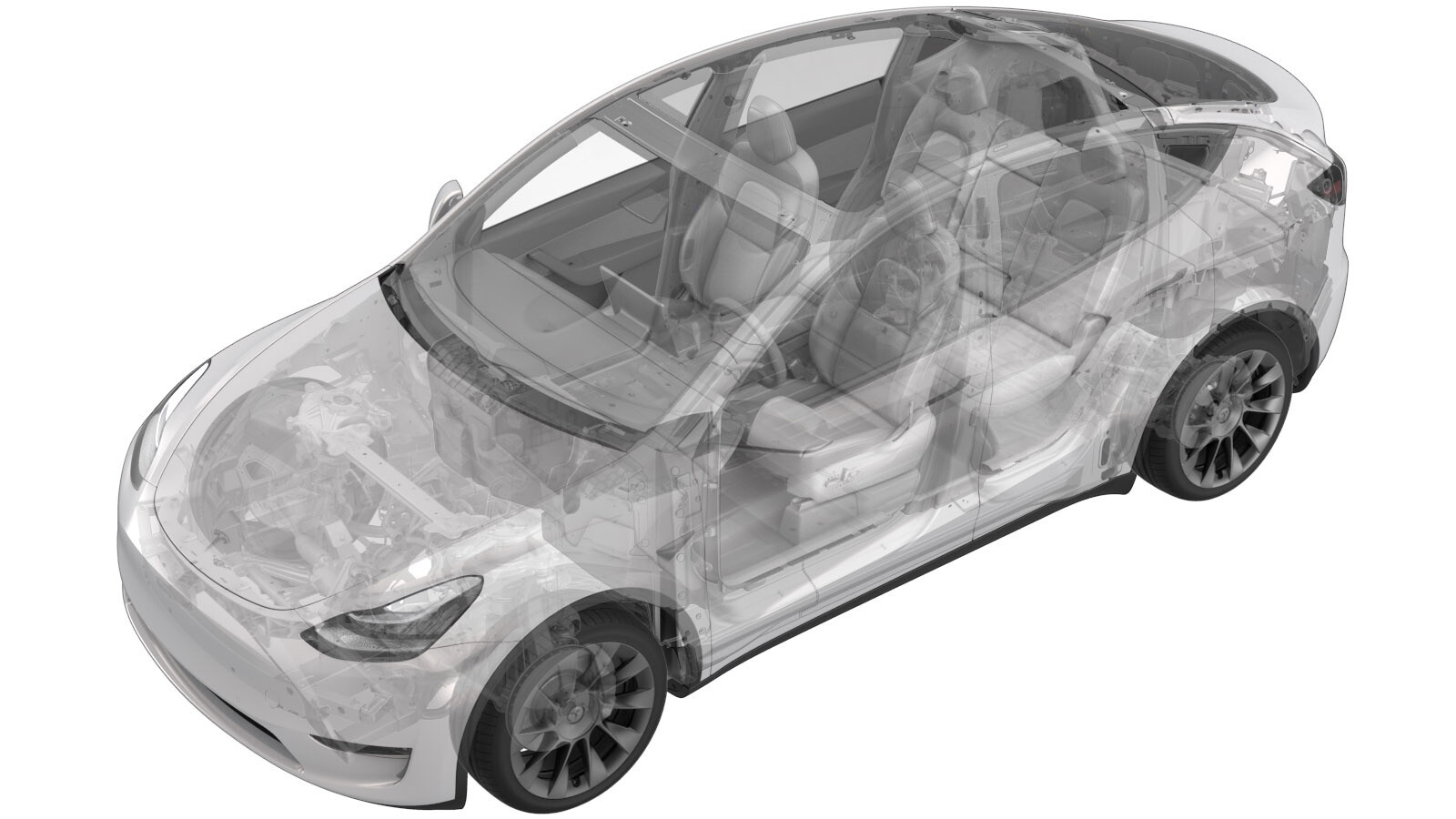Cover - Ancillary Bay (Structural Pack) (Remove and Replace)
 Correction code
16101042
1.50
NOTE: Unless otherwise explicitly
stated in the procedure, the above correction code and FRT reflect all of the work
required to perform this procedure, including the linked procedures. Do not stack correction codes unless
explicitly told to do so.
NOTE: See Flat Rate
Times to learn more about FRTs and how they are created. To provide feedback on
FRT values, email ServiceManualFeedback@tesla.com.
NOTE: See Personal Protection to make sure wearing proper PPE when
performing the below procedure. See Ergonomic Precautions for safe and healthy working practices.
Correction code
16101042
1.50
NOTE: Unless otherwise explicitly
stated in the procedure, the above correction code and FRT reflect all of the work
required to perform this procedure, including the linked procedures. Do not stack correction codes unless
explicitly told to do so.
NOTE: See Flat Rate
Times to learn more about FRTs and how they are created. To provide feedback on
FRT values, email ServiceManualFeedback@tesla.com.
NOTE: See Personal Protection to make sure wearing proper PPE when
performing the below procedure. See Ergonomic Precautions for safe and healthy working practices.
- 2023-11-08: Added/updated HV insulating glove steps.
High Voltage Awareness Care Pointsfor additional safety information.
Remove
- Open all the doors and lower all the windows.
- Remove the rear underhood apron. See Underhood Apron - Rear (Remove and Replace).
- Remove the HEPA filter assembly. See Assembly - Filter - HEPA (Remove and Replace).
- Move the front seats forward.
- Remove the 2nd row lower seat cushion. See Seat Cushion - Lower - 2nd Row (Remove and Replace).
- Remove the LH and RH lower c-pillar trims. See Trim - C-Pillar - Lower - LH (Remove and Replace).
- Remove the RH 2nd row seat back. See Seat Back - 2nd Row - RH (Remove and Replace).
- Remove the LH 2nd row seat back. See Seat Back - 2nd Row - LH (Remove and Replace).
- Disconnect LV power. See 12V/LV Power (Disconnect and Connect).
-
Verify operation of multimeter.
NoteSet multimeter to DC voltage, Confirm multimeter is properly measuring voltage by testing LV battery, Touch lightly and do not damage terminals.
- Perform Vehicle HV Disablement Procedure. See Vehicle HV Disablement Procedure (Structural Pack).
-
Remove HV insulating gloves.
CAUTIONIf flashing is present on the vehicle single-piece rear casting, put on cut-resistant gloves.
-
Lower vehicle until tires are touching
the ground.
NoteRaise lift off locks, then hold lock release lever to keep locks free while vehicle is lowered.
-
Disconnect HVC logic connector and
install logic cap.
Note1x connector, 1x cap, Release locking tab then pivot handle downward to release connector.
-
Disconnect power connector to HV
battery.
Note1x connector, Pull locking tab upward then release connection.
-
Disengage LH body harness from rear
body and move aside.
Note1x clip.
-
Remove bolt securing busbar cover
access door.
TIpUse of the following tool(s) is recommended:
- 10 mm socket
-
Remove bolts (x2) securing charge port
busbar kit to HV header.
TIpUse of the following tool(s) is recommended:
- 10 mm socket
-
Lift busbar kit connector to remove
from HV header.
NoteUse inflatable air bag to suspend busbar away from HV header during removal and installation.
-
Remove NVH insulation from ancillary bay
cover.
NoteMove insulation aside.
-
Remove fasteners (x3) securing
ancillary bay cover to high voltage controller.
TIpUse of the following tool(s) is recommended:
- External Torx E10
-
Release fasteners (x3) securing PCS
LVDC header to ancillary bay cover.
TIpUse of the following tool(s) is recommended:
- Torx T20 bit
-
Release fasteners (x2) securing charge
port header to ancillary bay cover and remove doubler.
NoteRelease charge port header from ancillary bay and remove plastic doubler, Take note of small tabs on shielding.TIpUse of the following tool(s) is recommended:
- EPL 10 socket
-
Put on HV insulating gloves and leather over gloves.
WarningContinue to wear the gloves until instructed to remove them.
-
Release perimeter bolts (x22) securing
ancillary bay to HV battery.
Notecaptured boltsTIpUse of the following tool(s) is recommended:
- EPL 10 socket
-
Remove ancillary bay cover from HV
battery.
NoteRecommend assistance, Lift up on the RH side and pivot the cover, Maneuver away from body casting and charge port components and HV header.
Install
- Inspect the inner edge of the vehicle single-piece rear casting for metal flashing. If flashing is present, put on cut-resistant gloves.
-
Inspect ancillary bay phantom seal to verify no damage is present.
NoteIf damage is present, Replace ancillary bay phantom seal.
-
Install ancillary bay cover onto HV battery.
NoteRecommend assistance, Guide LH side of cover into position clearing HV header, Maneuver cover past body casting and into position with charge port components.
-
Install perimeter bolts (x22) securing
ancillary bay to HV battery.
 5 Nm (3.7 lbs-ft)NoteThread bolts in evenly and torque.TIpUse of the following tool(s) is recommended:
5 Nm (3.7 lbs-ft)NoteThread bolts in evenly and torque.TIpUse of the following tool(s) is recommended:- EPL 10 socket
- Remove HV insulating gloves.
-
Secure doubler and install fasteners
(x2) securing charge port header to ancillary bay cover .
 10 Nm (7.4 lbs-ft)NoteSecure doubler onto header and install bolts, Take note of small tabs on shielding.TIpUse of the following tool(s) is recommended:
10 Nm (7.4 lbs-ft)NoteSecure doubler onto header and install bolts, Take note of small tabs on shielding.TIpUse of the following tool(s) is recommended:- EPL 10 socket
-
Install fasteners (x3) securing PCS
LVDC header to ancillary bay cover.
 2.5 Nm (1.8 lbs-ft)TIpUse of the following tool(s) is recommended:
2.5 Nm (1.8 lbs-ft)TIpUse of the following tool(s) is recommended:- Torx T20 bit
-
Install fasteners (x3) securing
ancillary bay cover to high voltage controller.
 10 Nm (7.4 lbs-ft)TIpUse of the following tool(s) is recommended:
10 Nm (7.4 lbs-ft)TIpUse of the following tool(s) is recommended:- External Torx E10
-
Install NVH insulation onto ancillary bay cover.
-
Connect power connector to HV battery.
Note1x connector, Push red locking tab down to secure connection.
-
Connect HVC logic connector.
Note1x connector, Pivot handle upward to engage connector and secure locking tab, Remove cap if needed.
-
Clean busbar HV connector contact surface of residual Penetrox.
NoteAllow 1 minute dry time after removing Penetrox, It is necessary to clean HV connector during re-use of busbar.
-
Clean HV connector contact surface of residual Penetrox.
NoteAllow 1 minute dry time after removing Penetrox, New busbar comes with Penetrox applied to HV connector.
-
Apply Penetrox onto HV connector joints.
NoteApply 2 drops of Penetrox A-13 about 5mm in diameter to either side of the hole on both leads, Spread evenly to verify the contact surface is fully covered.
-
Position busbar kit connector and lower onto HV header.
-
Install bolts (x2) securing charge
port busbar kit to HV Header.d
 9 Nm (6.6 lbs-ft)TIpUse of the following tool(s) is recommended:
9 Nm (6.6 lbs-ft)TIpUse of the following tool(s) is recommended:- 10 mm socket
-
Put on HV insulating gloves and leather over gloves.
NoteMake sure to wear Electrical Protective Gloves any time Hioki tester is used.
-
Perform Hioki resistance test at each HV joint from HV busbar lead to bolt
head.
Note2x HV joints, The acceptable resistance is between 0.050 mΩ (50 μΩ) and 0.195 mΩ (195 μΩ).If the resistance is greater than 0.195 mΩ (195 μΩ), there is too much resistance in the High Voltage joint. Remove the fastener, clean areas with isopropyl alcohol, install fastener back and test again.If the resistance is lower than 0.050 mΩ (50 μΩ), reposition the probes and measure again.If the resistance is repeatedly between 0.00 mΩ and 0.050 mΩ (50 μΩ), hioki test passed, proceed to next step.
-
Install fastener securing busbar cover
access door.
 9 Nm (6.6 lbs-ft)TIpUse of the following tool(s) is recommended:
9 Nm (6.6 lbs-ft)TIpUse of the following tool(s) is recommended:- 10 mm socket
- Remove HV insulating gloves.
-
Engage LH body harness onto rear body.
Note1x clip.
-
Raise vehicle fully and lower lift onto locks.
NoteSet vehicle to comfortable working height, Make sure there's an audible click of the locks on both sides before lowering, otherwise vehicle may tilt to the side.
-
Secure RDU HV harness onto HV battery.
Note1x connector, Verify lever is in the upright and open position, Carefully seat connector and allow lever to engage, Fully secure lever and verify red tab is locked, Do not damage any pins.
-
Apply Loctite 222 onto mid aero shield
bolts (x11) and install mid aero shield.d
 5 Nm (3.7 lbs-ft)NoteFasteners may vary, Model Y Structural Pack will one less bolt and one extra clip.TIpUse of the following tool(s) is recommended:
5 Nm (3.7 lbs-ft)NoteFasteners may vary, Model Y Structural Pack will one less bolt and one extra clip.TIpUse of the following tool(s) is recommended:- 10 mm socket
-
Install push clips at left and right wheel house liner to mid aero shield.
Note2x clips.
-
Lower vehicle fully.
NoteRaise lift off locks, then hold lock release lever to keep locks free while vehicle is lowered.
- Connect 12V/LV power. See 12V/LV Power (Disconnect and Connect).
- Install the HEPA filter assembly. See Assembly - Filter - HEPA (Remove and Replace).
- Install the rear underhood apron. See Underhood Apron - Rear (Remove and Replace).
- Install the RH 2nd row seat back. See Seat Back - 2nd Row - RH (Remove and Replace).
- Install the RH lower c-pillar trim. See Trim - C-Pillar - Lower - LH (Remove and Replace).
- Install the LH 2nd row seat back. See Seat Back - 2nd Row - LH (Remove and Replace).
- Install the LH lower c-pillar trim. See Trim - C-Pillar - Lower - LH (Remove and Replace).
- Install the 2nd row lower seat cushion. See Seat Cushion - Lower - 2nd Row (Remove and Replace).
- Move the front seats to original positions.
-
Remove vehicle from lift.
NoteLower rack arms fully and remove from under vehicle.
- Raise all four windows.
-
Close all four doors.
NoteIf 12V is powered up, Unlatch rear doors before closing.